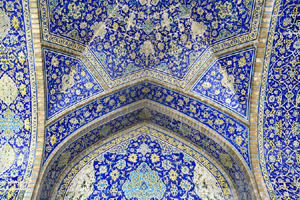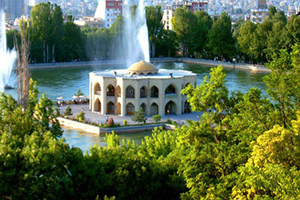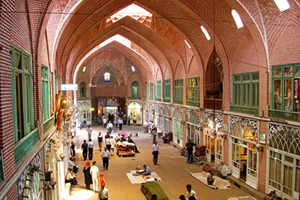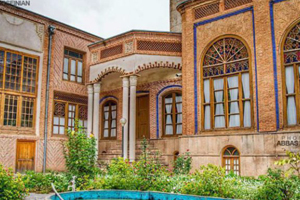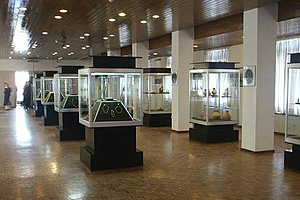Blue Mosque, as the most glorious edifice left from Kara Koyunlu era, was constructed by the order of Sultan Jahan Shah in 1465. It included a school, a bathhouse and also a bazaar. This fabulous mosque is called the turquoise of Islam due to its beautiful blue tiles. Blue Mosque (or Masjid-e Kabud) is one of the masterpieces of Islamic architecture that is located in Tabriz. The most remarkable features of this mosque are the especial blue tiles which are used in the exterior design, fascinating large dome and double-layered roof made of bricks and limestones. The tile work in harmony of colors along with delicate details and azure lines in the white background have made this mosque as a perfect example of Iranian architecture. Blue Mosque is one of the structures remained from glorious past and survived from one of the history’s catastrophic earthquakes in 1727. The blue mosque has been restored, however, only small parts of the original decoration remained, but the quality of the works, the finesse of the designs and the range of colors used are exceptional. Inside the mosque used to be tiled too, but many of them were destroyed during the earthquake and simply painted, but the tiles are almost complete now. In the past, Blue mosque was a collection of many buildings such as school, mosque, Khaneghah, library and etc. unfortunately nowadays none of them are left and only the mosque is restored. The eye-catching part of the mosque is the roof which gold and lapis lazuli are used to decorate it. Inside the mosque, there is a small cellar, where there are two graves that are likely to belong to Jahan Shah ibn Yusuf, the Kara Koyunlu leader, and his wife although these graves are empty now. Blue Mosque was registered as a national heritage in 1934 and from 1972 to 1975 a great deal of renovation has been done, and recently, renovation and completion of the building, interior, and exterior design have been carried out.
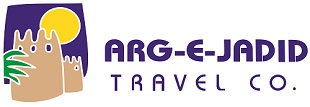
El Goli Historical Park is one of the most visited sites in Tabriz. It includes a small palace in the middle of a lake. The mansion, which was used as a royal summer resort during Qajar dynasty, presents traditional Iranian architectural style practiced in Azerbaijan. Shah Goli has been translated as “king’s pool”. The construction of this structure was attributed to Aq Qoyunlu dynasty and its development dates back to Safavid era. El-Goli Park was the largest water reservoir to irrigate gardens of east Tabriz before Safavid Dynasty but during this era a wall made of stone was dragged around interior part of the lake. During the Qajar era, some streets, flowers and walk sides were set up around El-Goli Park to decorate this promenade. Some fundamental renovations were done during Pahlavi era by Sayed Baqer Kazemi, the governor of the East Azerbaijan at that time. In the center of the El-Goli Park, there is an octagonal house, which is now used as a reception hall and is famous for El-Goli Palace. In addition to the coffee shop and restaurant located in El-Goli Park, the area around the lake is also a spectacular and beautiful place to walk and relax; there is also a possibility for the visitors to sail inside the lake.
Iran has always been famous among tourist due to its abundance of cultural, natural and historical attractions, this country also owns many registered UNESCO world heritage sites. One of them is astonishing Tabriz Bazaar. In ancient time, Tabriz used to be the place of cultural exchanges and the most important commercial center due to its location on the Silk Road. Historic bazaar complex consists of a great number of interconnected, covered, brick structures and buildings, it also comprises of enclosed spaces serving different functions. In the 13th century, Tabriz which was located in the province of north eastern Azerbaijan, was chosen as the capital city by Safavid kings, got famous and very profitable and as the result its cultural bazaar also gained a great deal of attention. The city had been remained as the capital till 16th century when Ottoman power invaded it, but that invasion did not have any effect on the fame and importance of the city and it continued to be a commercial hub till the 18th century. Tabriz Bazaar complex is the most complete instance representing cultural and commercial system in traditional Iran.
Amir Nezam House in Tabriz which later became the Qajar Museum is one of the most beautiful museums in the East Azerbaijan. Traditional Qajar architecture style is completely evident in this mansion. Visiting this mansion takes you back to Qajar dynasty and its lifestyle and traditions. Amir Nezam Garosi who was one of the politicians and writers during Qajar era constructed this mansion for himself. When Qajar dynasty collapsed, Pahlavi government used this mansion as Department of Finance. Unfortunately, what is remaining now is just some parts of this beautiful house and other parts were destroyed. In 1991, Cultural Heritage, Handicrafts and Tourism Organization of Iran bought Amir Nezam House and changed it into to Qajar Museum. The total area of this mansion is 3,000 square meters and the building is constructed in two floors with the porch having 16 beautiful columns. The mansion has two inner and outer courtyards along with pools and gardens that surrounded it and add extra beauty to this museum. The plaster works and interior mirror show the intelligence of Iranian art. When you enter the basement, you can see a large pool and magnificent columns which are unique in their kind. The first floor consists of 6 halls which are Sekeh hall, Bafteh, Chini, Abgineh, Felezat, Mosighi and Khatam hall. Also, the halls of the basement are Sang hall, Rojal, Faramin, Me’mari-o-Shahrsazi, Ghofl and Fanoos hall. Amir Nezam House in Tabriz was registered as a National Heritage Site in 1991.
Constitution House of Tabriz, built in 1868, is a historical house located next to the Grand Bazaar. The house was used as a gathering place for the leaders and activists of constitutional movement. The house was registered as National Heritage site in 1975 and was bought by Cultural Heritage, Handicrafts and Tourism Organization of Iran in 1988. Constitution House in Tabriz was built with Qajar architectural style and was the personal house of Haj Mehdi Koozekanani, a famous merchant who was a fan of freedom and liberty. Constitutional House in Tabriz is the most famous and honorable house and was the mansion where crucial decisions were made during Constitutional Revolution. After bombing National Consultative Assembly by Mohammad Ali Shah, the leaders gathered at the Constitutional House to consult the issues. Sash window, kiosk, woodcarving doors, Kolah Farangi and light well are some of the extraordinary features of this house. Many photos, sculptures and objects are exhibited, but the most distinguished historical objects are including Sattar Khan’s handgun, Constitution Carpet, personal stuff belonging to constitutional leaders and other documents, as well as statues and photos of that time. Visitors and tourists of Tabriz can visit Tabriz Constitutional Museum every day.
One of the tallest historical wall in Iran, which has been maintained after numerous natural and man-made disasters and became the symbol of Tabriz, is Arg-e Tabriz, which is also known as Arg-e Ali Shah. Arg of Tabriz is the remnant of a big unfinished 14th century mausoleum and a 19th century military castle and barrack in the city center. Traveling to Tabriz hundred years ago, you could have easily seen Arg-e Tabriz or as it was mentioned Arg-e Ali Shah because it was the only building that could have been seen even from outside of the city. Nowadays, to visit Arg in Tabriz, travelers have to go to the city center. The Arg was constructed in the 8th century during Gurkani or Timurid Empire. In order to construct this building with Azari Style architecture, Sarouj and durable building materials were used. A large part of Arg-e Tabriz was destroyed in the 1721 Tabriz earthquake along with many other buildings in the city and some of other parts were destroyed to build Tabriz Mosalla. Therefore; what we see now is just a small part of Arg-e Ali Shah which was established hundred years ago. The remnant now consists of three long walls. This monument is as wide as 30 meters and as tall as 26 meters and each wall is as wide as 10 meters. If you take a close look at the wall, you can see the footprint of bullets on this architectural masterpiece which dates back to Constitutional Revolution of Tabriz during Muhammad Ali Shah Qajar. After the Iranian revolution, a large mosque was built near it which is called Mosalla of Tabriz and it is used to hold official ceremonies and Friday prayers.
Human being has always been in need for scales and measuring tools to evaluate their environment and regulate their relationship with the surrounding nature. Certainly, the collection of old measuring instruments can illustrate the way in which technology was developed by the ancients. Sanjesh Museum or Measurement Museum in Tabriz is a two-story traditional house in the heart of Tabriz where elementary measuring instruments are kept. The house belonged to Salmasi family that was an old family in Tabriz during Qajar dynasty. Unique traditional architecture, sash windows with colorful glasses along with three pleasant lovey courtyards will catch the eyes of visitors at first sight. There is also a very old trunk which belongs to 5000 years ago and is a spectacular thing to see. The Salmasi house is now allocated to Sanjesh Museum to exhibit various measuring tools with delicate and imprecise weighing machines, metering tools and other evaluating scales such as watches from the past centuries, meteorological measurements, compasses and special assessment instruments for measuring length.
Known as the second historical museum after the National Museum, Azerbaijan Museum which is located in the vicinity of Blue Mosque is considered as one of the most important museums in Iran, since it exhibits astonishing Islamic and pre-Islamic objects. The museum consists of three Exhibition halls, some office rooms and a library. Azerbaijan Museum was designed by the French architecture, Andre Godard, and was built by Iranian artists. In the basement, along with a small restaurant, there are several tall bronze statues and in the garden, there are several impressive inscriptions and stone objects which mostly belong to Islamic era. The first floor displays coins from Achaemenes period to 19th century, seals from pre-historic to Sasanians period, plus archaeological department which contains pottery, carpets, candlesticks, and glass from about 650 A.D to 1900 A.D. The third gallery displays some sculptures which were created by Ahad Hosseini. Azerbaijan Museum with 2300 registered antique pieces and artistic handicrafts and also more than one thousand non-registered objects attract a great deal of attention and many tourists and culture lovers from around the world every year.
